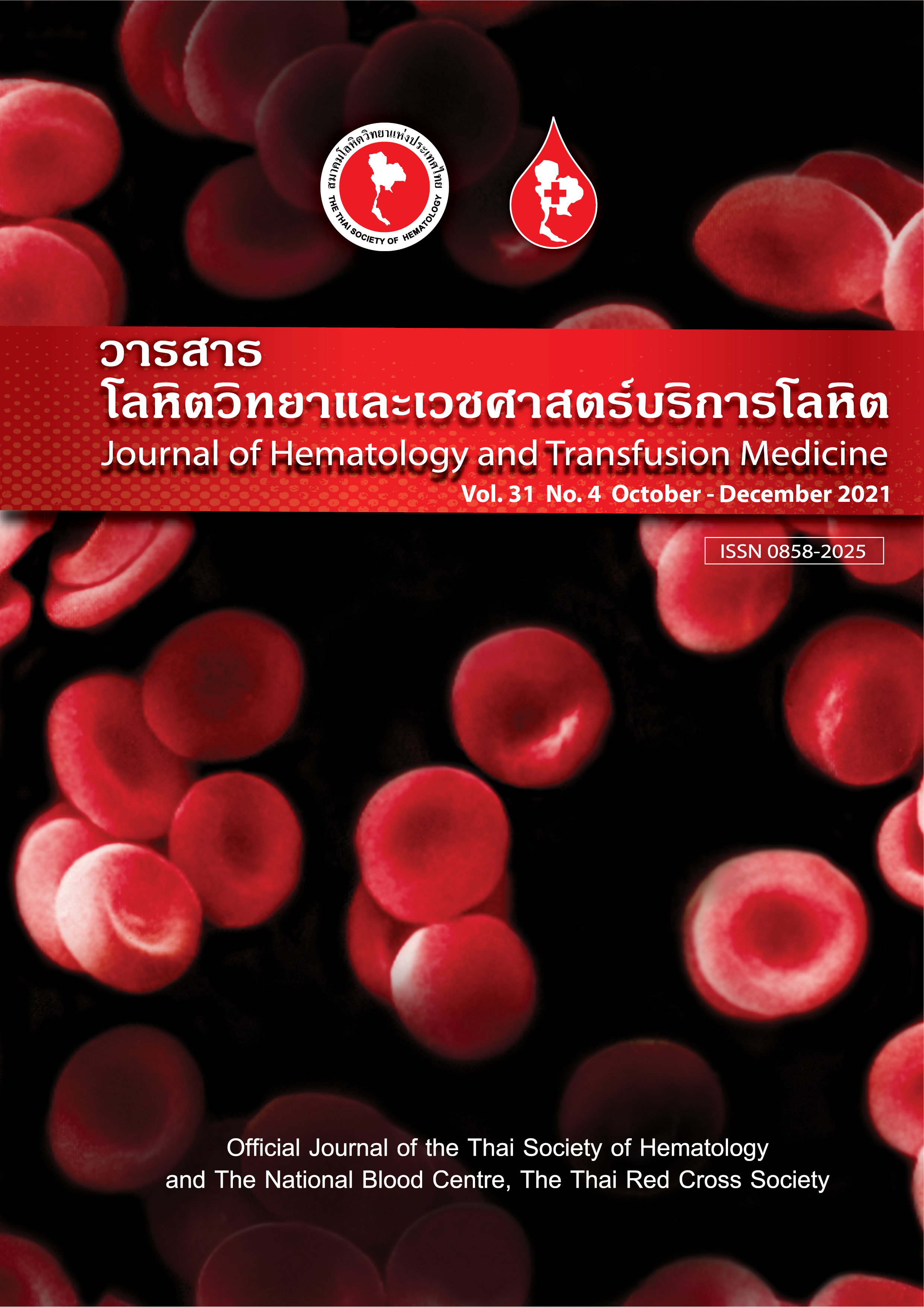การศึกษาความถี่ของแอนติเจน Dia และ Dib ในผู้บริจาคโลหิตของศูนย์บริการโลหิตแห่งชาติ สภากาชาดไทย
Keywords:
Diego blood group, Antigen Dib negative, Blood donorsAbstract
Abstract:
Introduction: Diego blood group system was found in a pregnant woman leading to death of the fetus. Dia antigen is typical for the Mongoloid people, but is very rare in Caucasoid and Negroid. Phenotype Di(b-) which is very rare in every race has never been reported in Thais. Both anti-Dia and anti-Dib can cause hemolytic disease of the fetus and newborn and hemolytic transfusion reaction. Objective: This study aimed to examine the frequencies of Dia และ Dib antigens in blood donors for the blood inventory of rare blood type and the preparation of standard screening and panel cells. Materials and Methods: Retrospective study of the phenotype of Dia and Dib antigens was performed by serological methods including manual standard tube technique, manual column agglutination technique and automated column agglutination technique using human monoclonal anti-Dia (IgM) clone HIRO-134(E5), human monoclonal anti-Dia (IgG) clone HIRO-71 and human monoclonal anti-Dib (IgG) clone HIRO-58 kindly provided by the Japanese Red Cross. The data of 188,859 blood donors was obtained from the donor’s database of National Blood Centre, Thai Red Cross Society during 1st June 2021 to 20th July 2021. The percentages of phenotypes Di(a-), Di(a+), Di(b+) and Di(b-) were calculated for antigen frequency, phenotype frequency and DI*A and DI*B alleles frequencies. Results: Among 5,285 blood donors, eleven donors were Di(b-) phenotype which eight of them were O Rh(D) positive, and one each of O Rh(D) negative, B Rh(D) positive, and AB Rh(D) positive, respectively. The percentages of phenotypes Di(a+), Di(a-), Di(b+), Di(b-) were 3.663%, 96.337%, 99.792% and 0.208%, respectively. Alleles frequencies were DI*A= 0.0183 and DI*B = 0.9817, respectively. Conclusion: Di(a-b+) was the major and Di(a+b+) was minor phenotype found in blood donors. Among 11 phenotype Di(b-) donors, 6 of them were used in the standard cells production and the other 5 were kept frozen for future use in patient who has anti-Dib. Interestingly, one donor of phenotype Di(a-b-) was found in this study which needed to be confirmed.
บทคัดย่อ
บทนำ หมู่เลือดระบบ Diego พบในปี ค.ศ. 1953 ในหญิงตั้งครรภ์ที่คลอดทารกซึ่งเสียชีวิตจากภาวะตัวเหลือง แอนติเจน Dia เป็นลักษณะที่จำเพาะของคนผิวเหลือง พบน้อยมากในคนผิวขาวและคนผิวดำ แต่พบมากขึ้นในชาวเอเชียและอเมริกันอินเดียน แอนติเจน Dib พบได้ในคนส่วนใหญ่ของโลก ส่วน phenotype Di(b-) เป็นโลหิตหายากในทุกเชื้อชาติ และยังไม่เคยมีรายงานในคนไทยมาก่อน อีกทั้ง anti-Dia และ anti-Dib สามารถทำให้เกิด hemolytic disease of the fetus and newborn และ hemolytic transfusion reaction ได้ วัตถุประสงค์ เพื่อหาความถี่ของแอนติเจน Dia และ Dib ในผู้บริจาคโลหิต สำหรับเก็บสำรองโลหิตไว้ให้ผู้ป่วยและนำไปผลิตเซลล์มาตรฐาน วัสดุและวิธีการ เก็บข้อมูลย้อนหลังการตรวจแอนติเจน Dia และ Dib ด้วยวิธีการทาง serology ได้แก่ manual standard tube technique, manual column agglutination technique และ automated column agglutination techniqueโดยใช้ human monoclonal anti-Dia (IgM) โคลน HIRO-134(E5), human monoclonal anti-Dia (IgG) โคลน HIRO-71 และ human monoclonal anti-Dib (IgG) โคลน HIRO-58 ที่ได้รับความอนุเคราะห์ จากสภากาชาดญี่ปุ่น จากฐานข้อมูลผู้บริจาคโลหิตของศูนย์บริการโลหิตแห่งชาติ สภากาชาดไทย ซึ่งเริ่มรวบรวมข้อมูลตั้งแต่วันที่ 1 มิถุนายน พ.ศ. 2564 จนถึงวันที่ 20 กรกฎาคม พ.ศ. 2564 นับเฉพาะผู้บริจาคโลหิตที่มีอายุ 17 ถึง 70 ปี เป็นผู้บริจาคโลหิตที่ทราบหมู่โลหิต ABO และยังมีชีวิตอยู่ จำนวน 118,859 ราย นำมาวิเคราะห์ด้วยการคำนวณหาร้อยละของฟีโนไทป์ Di(a-), Di(a+), Di(b+) และ Di(b-) และความถี่ของ อัลลีล DI*A และ DI*B ในผู้บริจาคโลหิต ผลการศึกษา ในผู้บริจาคโลหิตจำนวน 5,260 ราย พบฟีโนไทป์ Di(b-) จำนวน 11 ราย คิดเป็นร้อยละ 0.208 เป็นหมู่ O Rh(D) positive 8 ราย หมู่ O Rh(D) negative 1 ราย หมู่ B Rh(D) positive 1 ราย และหมู่ AB Rh(D) positive 1 ราย พบฟีโนไทป์ Di(a+), Di(a-), Di(b+) และ Di(b-) ร้อยละ 3.663, 96.337, 99.792 และ 0.208 ตามลำดับ ส่วนความถี่ของอัลลีล DI*A และ DI*B เท่ากับ 0.0183 และ 0.9817 ตามลำดับ สรุป ฟีโนไทป์ส่วนใหญ่ที่พบ คือ Di(a-b+) และรองลงมา คือ Di(a+b+) แต่ในกลุ่มฟีโนไทป์ Di(b-) 11 ราย มี 6 ราย ได้นำมาใช้ในการผลิตเซลล์มาตรฐาน และอีก 5 ราย ได้เก็บแช่แข็งสำรองไว้เพื่อให้แก่ผู้ป่วยที่มีฟีโนไทป์ Di(b-) หรือผู้ป่วยที่มี anti-Dib และต้องการรับเลือด ที่น่าสนใจคือในการศึกษานี้พบผู้บริจาคโลหิต 1 ราย มี ฟีโนไทป์ Di(a-b-) ซึ่งรอการตรวจยืนยันต่อไป
Downloads
References
2. Figueroa D. The Diego blood group system: a review. Immunohematology. 2013;29:73-81.
3. Chandanayingyong D, Sasaki TT and Greenwalt TJ. Blood Group of the Thais. Transfusion. 1967;7:269-76.
4. Nathalang O, Panichrum P, Intharanut K, Thattanon P, Nathalang S. Prevalence of DI*A and DI*B alleles frequencies and comparisons among central Thai and other populations. PLOS ONE. 2016. [Intenet] https://doi.org/10.1371/journal.pone.0165134.
5. Chesor M, et al. DI*A and DI*B Allele Frequencies Among Southern Thai Blood Donors.
Indian J Hematol Blood Transfus. 2018;34:506-9.[Intenet] doi: 10.1007/s12288-017-0886- 9. Epub 2017 Oct 10.
6. Fongsarum J, Nuchprayoon I, Yod-in S, Kupatawintu P, Kidprasirt C. Blood Groups in Thai Blood Donors. J Hematol Transfus Med. 2002;12:277-86. (in Thai)
7. Poole J. The Diego blood group system-an update. Immunohematology. 1999;15:1-9.
8. Choi JW, Kim MJ, Kim MH, Park JR, Kim HO. A Case of Mild Hemolytic Disease of the Fetus and Newborn-The Frist Case of Anti-Dib Identified on Prescreening Test during Pregnancy. Korean J Blood Transfus. 2010;21:165-70.
9. Nakajima H, Usui R, Kanda Y, Nakazato M. Another Example of Anti-Dib Presumably Stimulated by Transfusion. 1978. [Internet] https://www.jstage.jst.go.jp/article/jjtc1958/24/1-2/24_1-2_1/_pdf/-char/ja.
10. Oh EJ, Jekarl DW, Jeng HS, Park HI, Park YJ, Choi HA, Chun CS et.al. Severe Hemolytic Disease of the Newborn Due to anti-Dib Treated with Phototherapy and Intravenous Immunoglobulin. Annals of Clinical & Laboratory Science. 2008;38:80-2.



